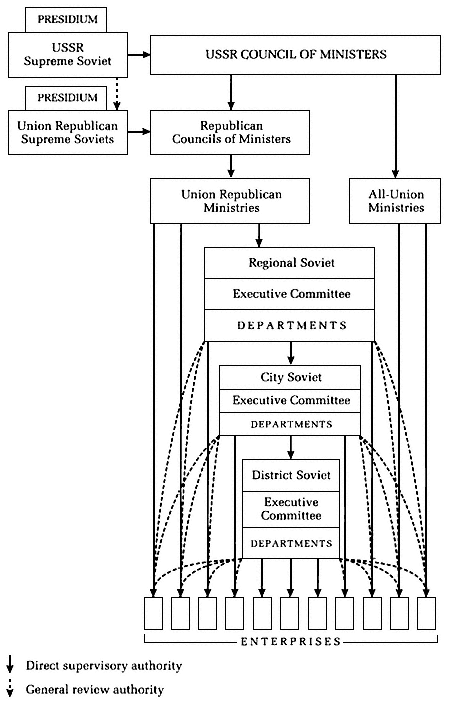Ministries vs. Municipalities
Stalin's new society was not only urban, it was also planned—planned from above. Soviet economic planning in its pure form has been all-encompassing, with every individual output predetermined by
central planners in Moscow, for whom no specification was too small to receive their undivided attention. Despite remarkable zealotry on the part of Stalin's planners, however, even they could not be everywhere at once. Hence, responsibility was delegated primarily to economic ministries organized along the production principle (i.e., each ministry was responsible for a limited number of interrelated economic sectors).
Such a chain of command established primary operating rules for a city's economic leaders, flowing downward from the national state planning agency, Gosplan,[14] through the industrial ministries to the individual enterprise, and eventually to the shop floor. At each regional level within the administrative hierarchy, however, ministerial officials were also attached to the primary regional governing body—the soviet—and were to act in accordance with the needs of the locality. This complex supervisory system created bureaucratic contradictions and tensions that have remained unresolved and continue to dominate Soviet municipal administration to this day.[15] Over time, it created an environment that required city and regional officials to serve as brokers and intermediaries between local and national interests.
State administration in the Soviet Union is based on a dual system of organizational subordination—a situation that prompted Mikhail Gorbachev's 1988 proposals for a reorganization of local administration. Local government agencies—the soviets—are responsible for the activities of their own constituent agencies and for the activities of institutions and organizations located within their territorial jurisdictions but not directly subordinate to them.[16]
As may be seen by examining the solid lines in Chart 1, "all-union" ministries are directly subordinate to the USSR Council of Ministers, while "union-republic" ministries are subordinate to republican councils, which, in turn, are subordinate to the USSR Council of Ministers. In other words, all-union ministries—which tend to be in heavy industry, such as the Ministry of Machine-Building—have no republic-level counterpart, operating as a single centralized unit for the country as a whole. Union-republic ministries such as the Ministry of Finance, on the other hand, are responsible for coordinating the work of ministries of the same name and similar purpose operating within each of the Soviet Union's fifteen republics. To complete this overview of the Council of Ministers, we should note that, in addition to ministries responsible for management of a single economic sector, several state committees retain responsibilities that cut across a number of economic branches and issue decrees that govern activities of more than one ministry. The USSR State Committee on Construction, Gosstroi, is one such institution that will appear from time to time in this volume.
Major enterprises are directly subordinate to either union-republic or all-union ministries. Less important enterprises, however, remain subordinate to regional or city soviets and to their administrative de-

Chart 1.
Territorial/ministerial supervision of enterprises
partments and agencies. Moreover, the regional and city soviets retain indirect responsibility and general review authority for the activities of all enterprises within their respective geographic areas (see dotted lines in Chart 1). Consequently, any plant in the Soviet Union serves two masters: its own national ministry and the local city soviet. While the ministry retains responsibility for guaranteeing adherence to planning norms established in Moscow, the local soviet seeks to coordinate the activities of all economic institutions within its territory, to ensure the optimally balanced development of its jurisdiction.[17] In this way, the soviet theoretically serves as the "master of the city" (khoziain goroda ), a status confirmed by constitutional, legislative, and administrative statutes.[18]
As already noted, factory managers are in reality rewarded and promoted by the ministries and not by the local governments, so that the ministries frequently hold the upper hand in various interactions among ministries, factories, and municipalities. Moreover, the linking of territorial and sectorial planning dramatically expands the economic functions of Soviet local administration beyond previously known limits. Municipal administrators become industrial managers, with a considerable portion of the local bureaucratic effort being directed toward economic functions that in the West are reserved for the private production sector.[19]
Strict hierarchy was also a major feature of Stalinist economic planning. Individual enterprises as well as entire sectors gained priority, or in less fortunate instances were relegated to subordinate status by central planners in Moscow. Each economic unit was assigned a priority ranking, access to valuable resources being determined by this relative primacy. Similarly, cities, towns, and municipalities across the Soviet Union were identified as serving national, republic, regional, or merely local interests.[20] Once locked into this hierarchy, a given city could flourish or fail accordingly. During a 1984 interview, for example, Leningrad urbanist Marat Mezhevich argued that his city's designation as one of national status with an individual listing in the USSR state budget guaranteed adequate capital for future economic growth and development.[21] Moreover, just a year earlier, the Politburo had generally extended the rights and responsibilities of local Leningrad and Moscow officials.[22] By contrast, leaders of other cities without such status must negotiate for resources with competing jurisdictions without the benefit of supporting central policy statements.
The establishment of a highly centralized planning system, followed by the evolution of a system of territorial administration in which local soviets assumed responsibility for the overall balanced development of their jurisdiction, has created a primary tension within the Soviet Union's system of municipal administration—a tension between economic sector and territorial unit, between ministry and municipali-
ty.[23] This continuous strain runs throughout the efforts of Leningraders to shape the face of their city, discussed in later chapters. It constitutes a particularly fateful legacy of the introduction of centralized planning by Joseph Stalin in 1928.